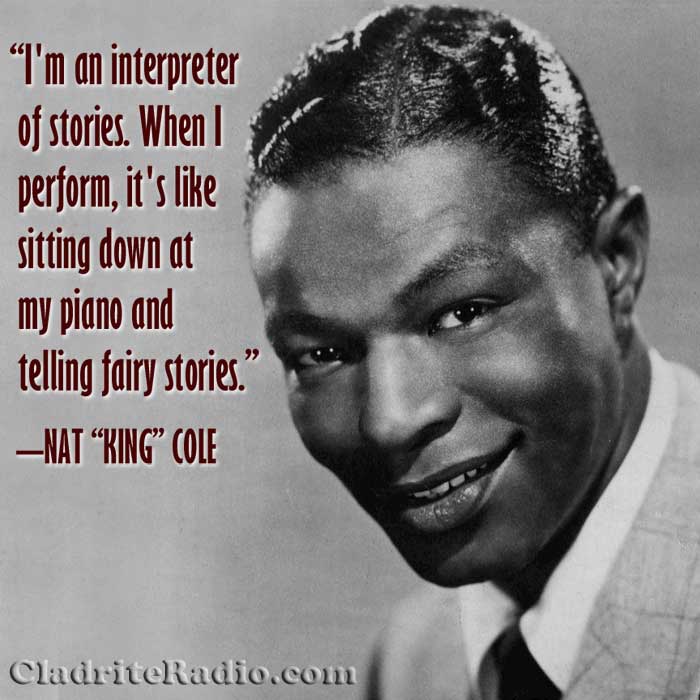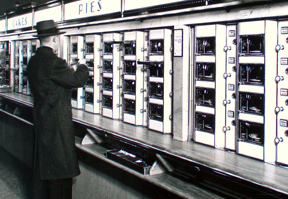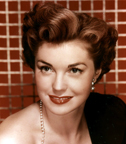Here are 10 things you should know about Agnes Moorehead, born 122 years ago today. Though she’s best known for a TV role, she also enjoyed success on the stage, in radio and in motion pictures.
Tag: Debbie Reynolds
10 Things You Should Know About Thelma White
Here are 10 things you should know about Thelma White, born 112 years ago today. Hers was a modest career, but she achieved a certain degree of lasting fame with her role in a popular cult film.
Happy 97th Birthday, Nat ‘King’ Cole!
Today Nat ‘King’ Cole, born Nathaniel Adams Coles 97 years ago today in Montgomery, Alabama, is widely associated with his pop hits of the 1950s and ’60s, but his musical career extends much further back, well into the Cladrite Era. He began performing as a jazz pianist during his teen years in the mid-1930s in Chicago. His older brother, Eddie, a bass player, joined his band and the two siblings cut their first record, under Eddie’s name, in 1936. It was during this time that Nat was given his ‘King’ nickname, said to be a play on the Old King Cole nursery rhyme.
Cole hit the road as the pianist in a national tour of Eubie Blake‘s revue Shuffle Along (currently being revived on Broadway), and when the show unexpectedly closed in Los Angeles, Nat decided that Southern California suited him and remained there.

Nat ‘King’ Cole found his first success as part of a trio (though they weren’t yet the King Cole Trio, as they would come to be known, but the King Cole Swingsters). Radio was key to their rise in popularity, and they became a popular act in the Los Angeles area. Nat’s piano playing was his claim to fame, but he had started to add vocals to a number of the tunes in the trio’s repertoire.
In 1943, Nat and the trio signed with the fledging Capitol Records, and their success financed the company’s growth. To this day, the round structure that is the company’s headquarters, built in Hollywood in 1956, is referred to as “the house that Nat built.”
Cole is to this day considered one of jazz’s greatest pianists, but eventually, the popularity of his vocals overtook the acclaim his playing garnered, and his flair for crooning a pop song made him one of the most popular recording artists in the world (it’s not widely remembered today, but in the 1950s, Cole outsold Frank Sinatra by a wide margin).
Cole became so popular that on November 5, 1956, he began hosting his own television show, The Nat ‘King’ Cole Show, on NBC; he was the first African-American artist to host such a show. The show did fine in the ratings, but no sponsor for the program was ever found, a must in those days. Just over a year after it hit the airwaves, Cole pulled the plug on the show. The strain of operating a show without a sponsor’s backing was too much. After the show’s demise, Cole was quoted as having quipped, with a mix of good humor and bitterness, “Madison Avenue is afraid of the dark.”
The program’s failure proved a negligible setback, as the hits kept coming. Cole even recorded a trio of albums in Spanish (phonetic only—he didn’t hablan español). His Spanish was reportedly pretty bad, but many Spanish-speaking listeners found his clumsy efforts charming and his popularity only increased.
A favorite story of ours tells of the time that Cole moved his family into Hancock Park, a all-white Los Angeles neighborhood that was a bastion of old money (by L.A. standards, anyway). The Coles were not made to feel welcome—a burning cross was even placed on their lawn. But when members of the neighborhood property-owners association paid Cole a visit, telling him they didn’t want to see any undesirables in the neighborhood, he is said to have told them, “Neither do I. And if I see anybody undesirable coming in here, I’ll be the first to complain.”
That, our friends, was a perfect response.
We once attended an afternoon question-and-answer session with Debbie Reynolds in Las Vegas, and she mentioned Nat ‘King’ Cole as one of her favorites. We asked her if she had known him well and did she have any remembrances to share? She recalled Cole as exceedingly gentle and kind, widely respected as performer and as a man. She said he wasn’t bitter at the racial prejudice and rancor he’d encountered over the years. “It’ll pass,” she quoted him as saying. “The years will go by and it will all go away.” We wish he’d lived to see the day; we hope we will.
In 1964, Cole began to experience fatigue and back pain until finally, some time after collapsing during a show at the Sands Hotel and Casino in Las Vegas, he was convinced to consult with a doctor while performing in San Francisco. He was diagnosed with lung cancer and given just a few months to live, but he kept working, recording his final sessions in early December. He died, aged 45, in Los Angeles on February 15, 1965, less than three months after his diagnosis. The severity of his condition had been largely hidden from the public, so the news of his passing proved a shock to his fans across the country and around the world.
We were not quite seven years of age when news came of Cole’s passing, and our beloved mother was one of those grieving fans. She loved Nat ‘King’ Cole’s music, and she passed that love on to us. He remains one of our favorites, and it pains us to think of all the wonderful music we’d have gotten to enjoy if he’d lived to his 70s or 80s, as other singers of the era, such as Sinatra and Tony Bennett, have done. But his musical legacy remains virtually unmatched. He excelled as a pianist and a singer, in jazz and in pop, and even managed to acquit himself reasonably well in recording a few country and R&B songs.
Thanks for all the wonderful music, Nat, and happy birthday, wherever you may be.
A Nickel’s Worth of Grub at the Automat
 We are fascinated by Automats, those self-serve restaurants that asked diners to drop nickels in slots in order to raise one of dozens of small glass doors to access a serving a meatloaf or apple pie.
We are fascinated by Automats, those self-serve restaurants that asked diners to drop nickels in slots in order to raise one of dozens of small glass doors to access a serving a meatloaf or apple pie.
Horn and Hardart opened the United States’ first Automat in Philadelphia in 1902, but they are mostly closely associated with New York City, where they thrived for decades before dying off in the 1980s and early ’90s. There were only a handful remaining when we arrived in the Big Apple in 1982, and we just made it to the last one before it closed in 1991.
But the Automat lives on in old (and not-so-old) movies, and we’ve devoted a playlist on the Cladrite Radio Youtube channel to scenes depicting these grand old eateries.
The most recent addition, from a 1925 silent called The Early Bird, can be viewed below, but if you wish to see full playlist of a dozen clips (and you do, take it from us), just follow this link. You’ll enjoy scenes featuring Joan Crawford, Ray Milland, Jean Arthur, Doris Day, Cary Grant, Debbie Reynolds, Sylvia Sidney, and many more.
Esther Williams: A Life Aquatic
 We were sorry to learn that the always lovely Esther Williams has backstroked off to the deep end of the pool at the age of 91.
We were sorry to learn that the always lovely Esther Williams has backstroked off to the deep end of the pool at the age of 91.
So we thought it an apt time to share (once again) with the Cladrite community an interview we did with the divine Ms. Williams some years ago on the occasion of the publication of her memoir, The Million Dollar Mermaid: An Autobiography.
Enjoy! But wait at least an hour after eating before beginning this Q&A.
An Interview with Esther Williams
In the 1940s and ’50s, Esther Williams was one of the brightest stars in MGM’s galaxy. Her movies, with their memorable Busby Berkeley-choreographed aquatic extravaganzas, remain hugely popular today in revival houses and on cable television.
And now, with the publication of her autobiography, Williams shares candid tales of her life as Hollywood’s “Million Dollar Mermaid.” We chatted with Ms. Williams about a wide range of topics, from her husband Fernando Lamas‘s sometimes philandering ways to cross-dressing in Hollywood. It was a conversation as lively and open as her book, The Million Dollar Mermaid: An Autobiography.
As we read your book, it struck us that you’ve have had a life filled with extreme highs and lows. There have been so many wonderful chapters in your life, but so many sad and tragic events as well.
It’s the idea that you’re smiling underwater—doing the impossible!—and then going home to a life that’s unraveling around you…I was struck with it, too. You know, writing your autobiography is therapy. You get in tune with a lot of things you thought you’d forgotten.
Fernando [Lamas] had asked me years ago not to be in the movies or television or do interviews anymore; as I say in my book, he asked, “Can you stop being Esther Williams?” And I said, “Well, that’s an interesting idea; I’ve been her for a lot of years. Let’s see how I do without her.”
And when Fernando died in 1982, the thing I noticed about the death of a life partner, especially one as difficult as Fernando was—when they go, you’re out of a job! The first person that called me after he died was Shirley Maclaine, who is my friend, and she said, “Well, Esther, you can finally get out of the house.” And I thought, Oh, Shirley, you tell it like it is. I’m so very fond of her.
And then Barbara Walters called. And I said, “Oh, Barbara, I haven’t been photographed in 20 years!” The one thing that Katharine Hepburn said that really made sense to me is that good thing about the talk shows is that people get to watch you rot. And I said, “I’ve been rotting in private!” And she said, “I’ve seen you at parties and you don’t look like you’re rotting to me. I want you to come and do one of my specials.” I said, “I’m not going to look good next to Jane Fonda or Sally Field.” And she said, “I won’t put you next to Jane Fonda and Sally Field; I’ll put you in the middle segment—we’ll put Mr. T before you and Howard Cosell after you, two of the ugliest men in the world.” And I said, “Oh, then I’ll do the show—of course!” [laughs]
Early in the book you detail a clinical experience with LSD. Later, you reveal that you were the victim of a rape at the hands of a family friend when you were a young woman, that your older brother died a tragic death when he was just in his teens. Was the book a form of catharsis for you?
You know, we seem to acquire, as we age and deal with various diminished capacities, an ability to articulate our feelings. To say, “No, no, you don’t understand. It wasn’t that way; it was this way.” And what happened to me is that, when I would go through the problems of day-to-day living, it was always wonderful to go to the studio and dive into that wonderful water. The water was very healing for me, and it remains so even today. I’m in my 70s. I had a knee replaced not so long ago and was going through physical therapy, and it hurt, you know? They’ve got to bring the muscles along, and it hurts.
So I said to Mark, my physical therapist—he came to my house to work with me, and he didn’t know how to swim—I said, “You’re $60 an hour, Mark. And you hurt. I don’t want to be hurting anymore; I’m going to get in the pool. And I tell you what we’ll do—we’ll call the $60 a push, because that’s what I’ll charge you for your swimming lesson. And I got him swimming, and he loved it.
What an opportunity for him, to receive a swimming lesson from Esther Williams! That’s a rare opportunity.
I thought it was worth the $60! Candy Bergen rang my doorbell one day and said, “I want [her daughter] Chloe to learn to swim.” And I said, “If you wanted her to learn to play piano, would you ring Artur Rubenstein‘s door?” And she said, “I don’t care if she plays piano, but she’s got to learn to swim.” And I said, “Yes, that’s true. Because that can save her life. Piano won’t ever save her life.”
Are you pleased—or perhaps surprised—by the rise of women’s athletics? Would you ever have imagined the sort of attention that’s been lavished on the U.S. women’s soccer team or the Olympic basketball players and gymnasts?
And synchronized swimming! It’s an Olympic sport now. Yes, it’s very exciting.
Read More »
